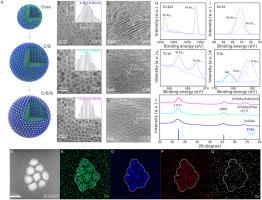Enhancing the efficiency and color purity of blue quantum dots through hybrid heat injection method
IF 4.2
3区 材料科学
Q2 MATERIALS SCIENCE, MULTIDISCIPLINARY
引用次数: 0
Abstract
Te doping is one of the most efficient approaches to tune the emission of ZnSe-based quantum dots (QDs) from violet window to blue light window. However, the widely used non-mixed injection methods involving separated injection of Se- and Te-precursors will induce irreversible heterogeneous nucleation distribution or self-nucleation. In this paper, a reasonably designed simultaneously injection method was developed, which involves heating the Se-DPP precursor solution and the Te-TOP precursor solution to 120 °C before rapidly mixing and injecting them into the reaction solution. It can be proven that Te and Se are uniformly distributed throughout the crystalline domains. After overcoating ZnSe and ZnS shells, the prepared ZnTeSe/ZnSe/ZnS QDs exhibited a pure blue emission wavelength of 452 nm with over 60 % quantum yield (QY). These QDs also feature high color saturation. Compared to the ZnTeSe/ZnSe/ZnS QDs synthesized by non-mixed injection methods, their full width at half maxima (FWHM) has been reduced from 30 to 17 nm. Furthermore, after being treated with ZnCl2 passivation, the QY of the prepared QDs exceeds 90 %. These results demonstrate a feasible approach for achieving high color purity ZnSe-based blue QDs, which could significantly advance the development of environmentally friendly quantum dot displays.

采用混合热注入法提高蓝色量子点的效率和色纯度
掺杂是将znse基量子点发射从紫光窗口调整到蓝光窗口的最有效方法之一。然而,目前广泛使用的非混合注射方法,即分离注射Se-和te -前驱体,会导致不可逆的非均相成核或自成核。本文设计了一种合理的同步进样方法,将Se-DPP前驱体溶液和Te-TOP前驱体溶液加热至120℃,快速混合后注入反应溶液。结果表明,Te和Se在晶畴中均匀分布。包覆ZnSe和ZnS壳层后,制备的ZnSe/ ZnSe/ZnS量子点具有452 nm的纯蓝色发射波长,量子产率(QY)超过60%。这些量子点还具有高色彩饱和度。与非混合注射法合成的znese /ZnSe/ZnS量子点相比,它们的半峰全宽度(FWHM)从30 nm减小到17 nm。此外,经ZnCl2钝化处理后,所制备的量子点的QY超过90%。这些结果证明了一种实现高色纯度znse基蓝色量子点的可行方法,可以显著推动环保量子点显示器的发展。
本文章由计算机程序翻译,如有差异,请以英文原文为准。
求助全文
约1分钟内获得全文
求助全文
来源期刊

Optical Materials
工程技术-材料科学:综合
CiteScore
6.60
自引率
12.80%
发文量
1265
审稿时长
38 days
期刊介绍:
Optical Materials has an open access mirror journal Optical Materials: X, sharing the same aims and scope, editorial team, submission system and rigorous peer review.
The purpose of Optical Materials is to provide a means of communication and technology transfer between researchers who are interested in materials for potential device applications. The journal publishes original papers and review articles on the design, synthesis, characterisation and applications of optical materials.
OPTICAL MATERIALS focuses on:
• Optical Properties of Material Systems;
• The Materials Aspects of Optical Phenomena;
• The Materials Aspects of Devices and Applications.
Authors can submit separate research elements describing their data to Data in Brief and methods to Methods X.
 求助内容:
求助内容: 应助结果提醒方式:
应助结果提醒方式:


